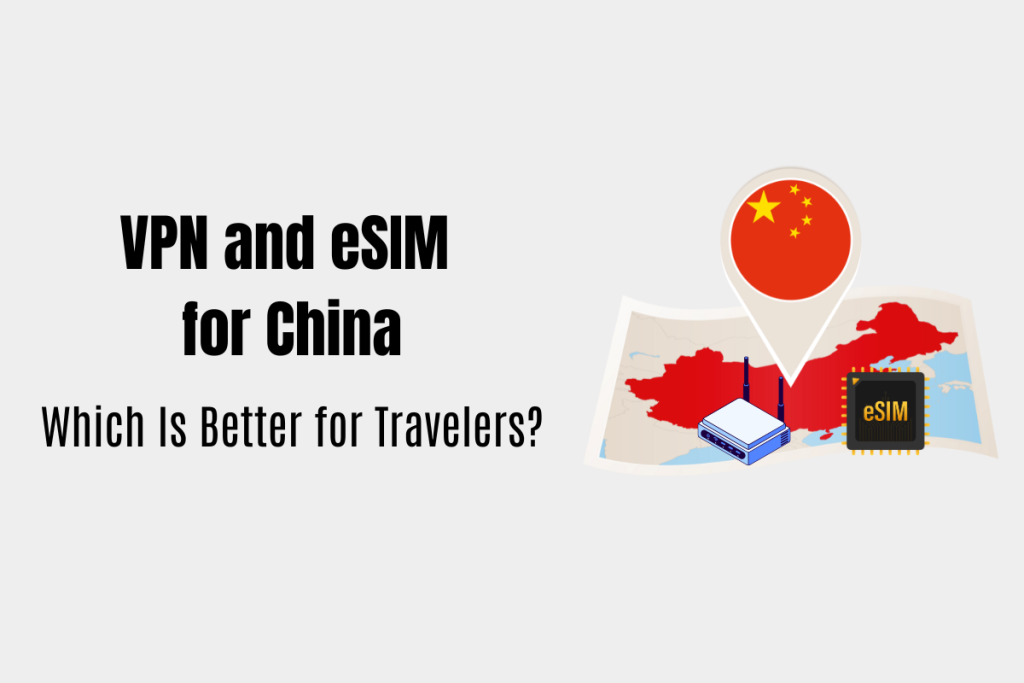China’s “Great Firewall” blocks access to many essential services like Google, WhatsApp, and social media, creating challenges for international travelers. Two solutions exist to overcome these restrictions: VPN and eSIM technologies. Traditional VPNs face increasing reliability issues, while specialized eSIMs offer a more seamless alternative without technical setup. This guide compares both VPN and eSIM options to help you choose the best way to stay connected during your China trip.

I. Why Internet Access in China Is Different
China’s internet operates behind what’s known as the “Great Firewall,” a sophisticated digital barrier that restricts access to many popular international websites and services.
What’s blocked in China:
- Google services (Gmail, Maps, Search, Drive)
- Social media (Facebook, Instagram, Twitter/X)
- Messaging apps (WhatsApp, Telegram)
- Streaming services (YouTube, Netflix)
- News sites (BBC, New York Times)
Travelers often discover these restrictions only after arriving, leaving them disconnected from their usual communication channels, maps, and information sources. When faced with this challenge, visitors typically have two options: using a VPN or getting a specialized eSIM.
II. Option 1 – VPN in China
A VPN (Virtual Private Network) creates an encrypted tunnel to servers outside China, theoretically allowing access to blocked sites. While VPNs have been the traditional solution, they come with significant limitations.
Advantages:
- Can provide access to blocked websites and apps
- Works with your existing SIM card or Wi-Fi connection
Many travelers attempt to use VPNs, but the experience is often frustrating. The Chinese government actively works to detect and block VPN connections, leading to unreliable service.
Disadvantages:
- Many VPNs are actively blocked by the Chinese government
- May be considered legally questionable for visitors
- Often slow and unreliable connection speeds
You typically need to download and set up your VPN before arriving in China. Since app stores are blocked, installing a VPN after arrival is extremely difficult.
II. Option 2 – eSIM for China
An eSIM is a digital SIM card built into your device that offers a more elegant solution for China travelers. Unlike physical SIMs, it works through a simple QR code scan.
How it works:
- Purchase a plan online before your trip
- Scan the QR code you receive via email
- Activated upon arrival in China
Specialized China eSIMs provide access to both Chinese and global internet services without requiring VPN software.
Compatible with:
- iPhone XS and newer (except mainland China versions)
- Samsung Galaxy S20+ and newer
- Google Pixel 4 and newer
Most devices purchased in the last 3-4 years support eSIM technology, but phones bought in mainland China typically don’t have this functionality due to local regulations.
III. VPN vs eSIM: Comparison
When choosing between a VPN and specialized eSIM for your China trip, several key factors should guide your decision. The table below highlights the main differences, but let’s explore what these mean in practice.
| Feature | VPN | China eSIM (No VPN) |
| Access to Google/WhatsApp | ✅ | ✅ |
| Requires Installation | ✅ | ❌ |
| Blocked by Firewall | ⚠️ Possible | ❌ |
| Activation Time | Medium | Instant |
| Risk for Tourists | ⚠️ Maybe | ✅ Safe |
| Ease of Use | ❌ Complex | ✅ Simple |
For most travelers, the ease and reliability of eSIMs make them the superior choice, especially if you’re visiting for a short period or need consistent access to international services.
IV. Best eSIM Plans for China (No VPN Needed)
Chinaesim.com offers plans powered by China’s major networks (China Mobile, China Telecom, China Unicom):
| Plan Type | Validity | Price | Best For |
| China eSIM – No VPN Required | 3–30 days | From $2.50 | Most popular |
| Fixed Data Plans (1–20GB) | 3–30 days | From $4.90 | Light users |
| Unlimited Data Plan | 3–30 days | From $13.90 | Heavy users |
| China + Hong Kong + Macau | 5–15 days | From $8.50 | Cross-border trips |
| China + Thailand + Vietnam | 5–30 days | From $9.90 | Backpackers |
When selecting an eSIM plan for your China trip, consider both your data needs and travel itinerary. Light users checking emails and occasional maps might find the Fixed Data Plans sufficient, while those needing constant connectivity should opt for Unlimited Data.
If your journey includes multiple Asian countries, the multi-country plans offer significant value by eliminating the need to purchase separate eSIMs for each destination. Based on customer reviews and overall value, the standard “China eSIM – No VPN Required” plan provides the best balance of price and performance for most travelers.
V. FAQs
Can I access Google and Instagram?
Yes, these eSIMs provide access to internationally blocked sites and apps. You’ll be able to use Google services (including Gmail, Maps, and Search), social media platforms like Instagram and Facebook, and messaging apps such as WhatsApp and Telegram normally.
Can I use eSIM with my physical SIM?
Yes, most modern phones support dual SIM functionality, allowing you to keep your home number active. You can configure your device to use the eSIM for data while keeping your regular SIM for calls and texts, making it easy to stay in touch with contacts at home.
Is this legal?
Yes, these services are safe and legal for tourists to use. Unlike VPNs which operate in a legal gray area in China, these specialized eSIMs use approved commercial partnerships with Chinese mobile operators and are specifically designed for international travelers.